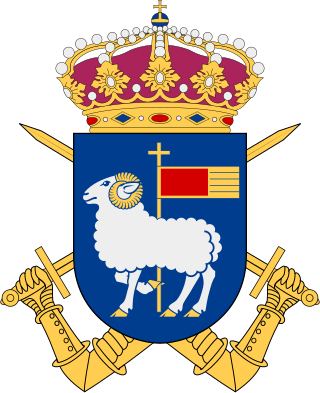
The Gotland Regiment is a Swedish Army armoured regiment which has been active in various forms between 1963–1994 and 2000–2005, when it was disbanded. The regiment was re-established on 1 January 2018. The regiment is based in Visby as part of the Gotland Garrison.
Lower Norrland Military District, originally II Military District was a Swedish military district, a command of the Swedish Armed Forces that had operational control over Lower Norrland, for most time of its existence corresponding to the area covered by the counties of Västernorrland, Jämtland and the northern part of Gävleborg. The headquarters of Milo NN were located in Östersund.
An army division or division was during the 1900s in the Swedish Army a designation for a larger military unit, comprising two or more brigades, an artillery regiment, an engineer battalion, an anti-aircraft battalion, a signal battalion and a transport battalion. An arméfördelning corresponds to a division in many countries' armies, and it has been common to also use the word "division" in Swedish when referring to foreign rather than Swedish military units.

Gotland Military Command previously VII Military District was a military district, and later a command in the Swedish Armed Forces. It existed between the years 1942 and 2000. The staff of the military district was located within Gotland Garrison in Visby on Gotland.
Gotland Military District was a military district within the Swedish Armed Forces active between 2000 and 2004. The staff was located within Gotland Garrison in Visby on Gotland.

The Eastern Army Division, was a division of the Swedish Army that operated in various forms from 1941 to 2000. Its staff was located in Strängnäs Garrison in Strängnäs. The unit was disbanded as a result of the disarmament policies set forward in the Defence Act of 2000.
The 1st Air Command, previously named Air Command and later named Attack Command was an air group unit in the Swedish Air Force. The 1st Air Command was the collective name given to the attack wings who would jointly carry out heavier attacks in the event of war. It was active in various formations from 1938 to 1995. It was directly subordinate to the Supreme Commander of the Swedish Armed Forces and therefore nicknamed ÖB:s klubba.

The Swedish Army Service Troops is the military logistics branch of the Swedish Army. The task of the troops is to train personnel for maintenance units, provide supplies, repair damaged equipment, retract and care for sick personnel as well as in the event of war mobilizing them. The troops are today fully motorized.

The Göta Life Guards, designated P 1, was a Swedish Army armoured regiment that was active in various forms 1944–1980. The unit was based in the Enköping Garrison in Enköping and belonged to the King's Life and Household Troops until 1974.
The Northern Military District was a military district within the Swedish Armed Forces from 2000 to 2005. Its staff was located in Boden Garrison in Boden, Sweden. The military district included Västernorrland, Jämtland, Västerbotten and Norrbotten counties.
The Defence District Commander within the Swedish Armed Forces was a senior commanding officer who led forces in a geographical/military territorial district, or within a specific area of responsibility. The post was created in 1942 in connection with the Defence Act of 1942 and was terminated in 2000 through the Defence Act of 2000.

The Swedish Armed Forces Centre for Defence Medicine is a tri-service military medicine center in the Swedish Armed Forces. Its staff is made up of officers, civilian specialists, group commanders and officer reservists – tasked with ensuring care is provided during peacetime, on international missions, at times of crisis and in combat.

The military subdivisions of Sweden refers to the division of Sweden's territory with regard to the command possibilities, mainly in war. The subdivisions are different depending on Sweden's military doctrine. The subdivision can apply to both land and sea territory. On 1 January 2013, the Swedish Armed Forces re-established regional staffs, dividing the country into four military regions. A fifth military region was formed in 2019.

The West Coast Naval Command was a naval command within the Swedish Navy that operated in various forms in from 1928 to 2000. The unit was based in Gothenburg.
The Southern Military District was a military district within the Swedish Armed Forces from 2000 to 2005. Its staff was located in Gothenburg, Sweden. The military district included Jönköping, Kalmar, Blekinge, Skåne, Halland and Västra Götaland counties.
Lieutenant General Sven-Åke Jansson was a senior Swedish Army officer. He served as commander of Gotland Military Command (1988–1994) and as Commanding General of the Southern Military District (1994–1998).
The Central Military District was a military district within the Swedish Armed Forces from 2000 to 2005. Its staff was located in Strängnäs, Sweden. The military district included Stockholm, Uppsala, Södermanland, Östergötland, Värmland, Örebro, Västmanland, Dalarna and Gävleborg counties.
The Southern Air Command was an air command within the Swedish Air Force that operated from 1994 to 2000. The unit was based in Ängelholm. It was responsible for air surveillance over South Sweden.
The 2nd Air Command was a unit in the Swedish Air Force. The 2nd Air Command was the collective name given to the bomb and fighter wings who would jointly carry out heavier attacks in the event of war. It was active between 1942 and 1966.









